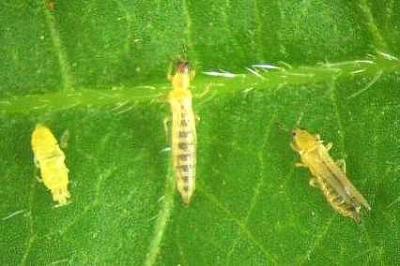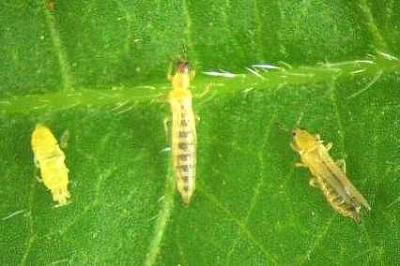

(Some species of Haplothrips are reported as pest in South Africa, we do not know if they are pests in Kenya or east Africa. Haplothrips are present in East Africa, but some of them are beneficial (predacious) and we do not know the status on the region. This will have to be reviewed when we finish with the datasheets). [br] When the status of Haplothrips in East Africa has been clarified we could decided if we leave this information on egg-laying habits. [br] Biological pesticides: check with list of Seif [br] FW: Include information on synthetic pesticides?
Thrips (Megalurothrips spp. and Frankliniella schultzei)
Thrips are small (1.5 mm long), slender, brown insects with pale yellow hind wings that appear as a yellow line down the back of the body when the insect is at rest. Adult thrips have characteristic wings; the transparent wings have a fringe of hairs around the outside edge standing out in the same plane as the wing.
Several species of thrips are common on pigeon peas in Eastern Africa and are considered important pests. These thrips feed on leaves and flowers. Main damage is due to thrips feeding on flower buds and flowers. Heavy infestation can lead to shedding of buds and flowers. However, according to reports from India, pigeonpea plants produce more flowers than the plant can sustain, so many are lost naturally and it is difficult to assess thrips damage (Ikisan, 2000).
- Conserve natural enemies. Predatory mites and pirate bugs are important for the natural control of thrips. For more information on natural enemies click here
- Monitor the crop regularly. Early detection is particularly important at the onset of flowering.
- Whenever necessary spot spray the crop with botanicals. Some plant extracts (e.g. garlic, rotenone, neem, pyrethrum and a mixture of garlic and pepper etc.) are reported to control thrips. Spinosad, a bacterial derivative, is effective in controlling thrips.
